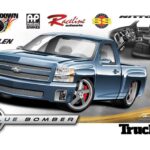We don’t know what it takes to drive from California to Alaska in December behind the wheel of a ’68 Ford Ranchero. If you read the story about our latest road trip (“Alaska Colorado Arizona Death Trip”, Apr. ’12), you saw that we planned to drive this car to an ice race in Big Lake, Alaska, but ended up on a trek from California to snowy Idaho, to freezing Colorado, onto balmy New Mexico, through rainy Arizona, and back home again. The fiasco took us 3,000-plus miles through snowstorms, across a river, and through the naked desert after thrashing for a week to build the car. Last month, we covered the adventure. This time, the dirty details of our Ak Miller/Ray Brock HOT ROD Spl. clone.
Back in November 1967, Miller and Brock campaigned a lightly prepped ’68 Ranchero GT in the Mexican 1,000 Rally, the off-road-racing precursor to the Baja 1,000. The duo won their class with a virtually stock Ranchero with a 390 and a four speed, and outfitted with oversize tires, driving lights, and a few small suspension mods that included limit straps for the rear shackles. The 1,000 was more of a dirt-road rally back then instead of today’s jumps-silt-rocks-ditches torture test, but the win was still impressive. We’ve lusted over that long-gone project car for years, and this road trip was the perfect excuse to buy an old Ranchero and fix her up like that historic racer.
So we did. In a week. We replaced the engine and trans, rebuilt the rear axle and suspension, rewired, replumbed and rejuvenated almost the entire car. Oh, and we had the car striped and lettered because our schedule wasn’t hectic enough as it was. It worked! Here’s the lowdown on the RAUNCHero. Raunchy for short.
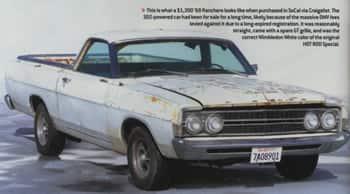 |
This is what a $1,300 ’68 Ranchero looks like when purchased in SoCal via Craigslist. The 302-powered car had been for sale for a long time, likely because of the massive DMV fees levied against it due to a long-expired registration. It was reasonably straight, came with a spare GT grille, and was the correct Wimbledon White color of the original HOT ROD Special. |
| The carbureted 302 had a serpentine accessory drive. We pegged it as a mid-‘80s Mustang engine backed by an FMX automatic trans. Neither unit functioned very well. The day we picked up the RAUNCHero was also the day the drivetrain and exhaust were ripped out and pushed into the corner of the shop. We’re eyeballing a roadster project as a potential home the Raunchy powerplant. | 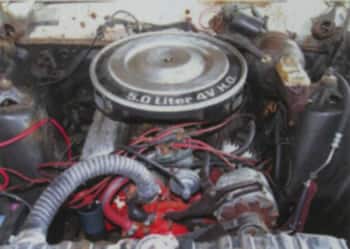 |
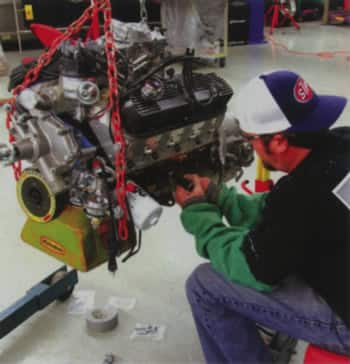 |
The new engine is a Dart 363 based on the 302 Ford but with a larger 4.125 bore and longer 3.400 stroke. Dart 195 heads and dished pistons equal 9.26:1 compression. We ran the engine with a Comp Cams NX 282 hydraulic roller cam, and the engine made 470 hp with an Edlebrock RPM Air-Gap intake and a 750 Holley double pumper. Our thermal barrier-coated Hedman Elite Ultra-Duty street headers weren’t built for the raised-port heads or the massive bellhousing of our Gearstar C4 trans. We had to notch the bell and grind the block to bolt them up. |
| This angle gives you an idea how much material was removed to fit the 3-inch collectors and 1 5/8-inch primary tubes. |  |
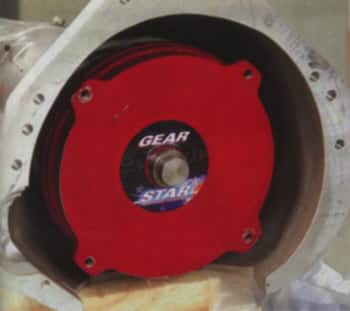 |
Our 11-inch, fully welded converter is a billet part. Its computer balanced, stalling at 2,700 rpm with 2.80:1 gears in the rear and 27-inch tall tires. It’s surrounded by an SFI-approved, heavy duty aluminum Ultra-Bell housing that is certified for NHRA or off-road racing and will keep our toes intact should we find a way to grenade the tranny. |
| We’ve learned to prefit headers and starters before dropping the engine into any car, especially during a swap. In addition to a Lokar dipstick and a trans cooler, Gearstar included a new, laser-cut mid-plate to bolt between the C4 and engine block; it’s a handy universal plate that can handle either of the starter offsets used on the small Fords. For our application, this knockout had to be removed from the mid-plate. We used a Powermaster XS Torque gear-reduction starter. | 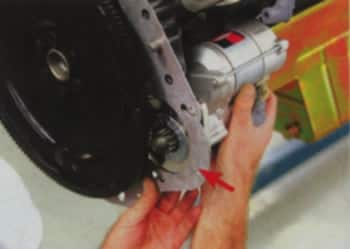 |
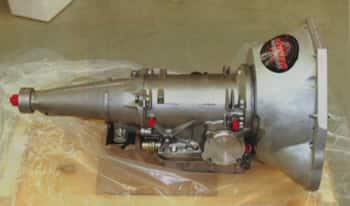 |
Desperate times call for desperate measures. We needed a trans would bolt right up to the 363 and handle any abuses we dished out road trip and eventual racing events [with even more power, see page 80]. A mass-produced unit wouldn’t do, and since we had an incredibly brief timetable, we needed a builder with the manpower to make it happen now. Gearstar Performance didn’t flinch when we spec’d a C4 capable of handling 750 hp. 700 ft-lbs of torque, and overnight delivery. |
| The company’s Level IV C4 trans is handbuilt by a master tech and dyno-tested in-house with the converter in place for the equivalent of 100 road miles. The internals, including the six-pinion planetary gearset, are all hardened and stress-relieved, and billet parts are used throughout. The valvebody is a custom piece that allows up and down shifts at any speed, and it also has compression braking. The input shaft and forward drum are 300M material, and the bands are made from Kevlar and are carbon fiber for this application. A high-output pump and max-capacity ribbed pan are part of the package, too. It’s a tout piece that we enjoyed torturing in the snow and dirt and while towing. | 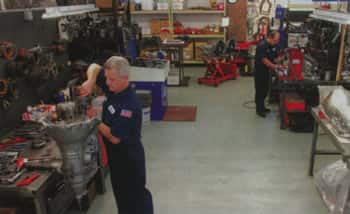 |
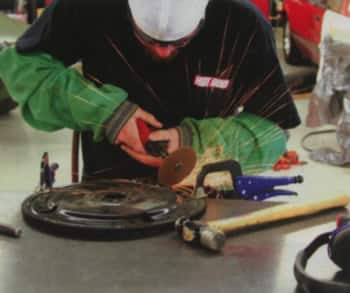 |
It was quicker to cut the weight off a flexplate designed for an externally balanced rotating assembly than to hunt down one for our internally balanced parts. Corners sometimes get sliced n’ diced when the clock is ticking louder than a set of wasted solid lifters. |
| We spent two full days repairing rust in the cab while waiting for a few small items that prevented us from installing the new engine. Meanwhile, Car Craft staffer John McGann prepped the hood and front fenders before spraying satin-black Rust-Oleum from Home Depot on the parts [in our parking lot in the dark around midnight]. He pulled a similar feat when we needed to paint the hood of the Crusher Camaro a while back. |  |
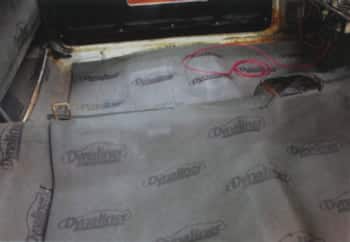 |
Jesse Kiser drove all over Los Angeles and Orange County trying to find new bushings for the worn-out leaf springs. The bushings were so bad that the shackles had flipped forward and were stuck against the framerails when we bought the car. Deaver Suspension came to the rescue with new bushings and center pins. Problem solved! |
| In addition to installing a Summit Racing universal heater kit, we lined the entire cab in Dynamat products. The floor received a layer of Dynamat Extreme, plus ½-inch thick Dynaliner, which did a great job of insulating our feet from the sheetmetal. | 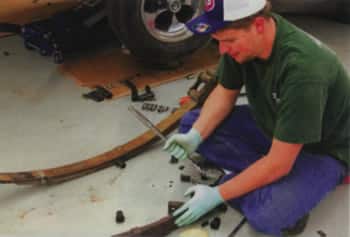 |
 |
Painter Jeff Styles used a combination of stencils and a steady hand to replicate the originals HOT TOD Spl. Livery. He worked his magic between the suspension and engine installation. Actually, he lettered the Ford while we took a break to have a donut-eating contest between HR staffer Brandan Gillogly and Super Chevy Tech Editor Calin Head. |
| Right inset: Aside from a leaking rear seal, the only real hiccup with the engine swap was lining up the lower pulley with the alternator and water pump pulleys. | 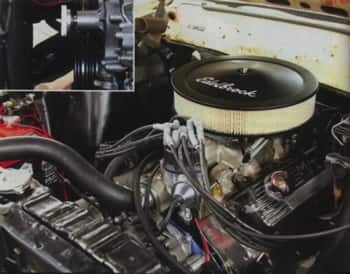 |
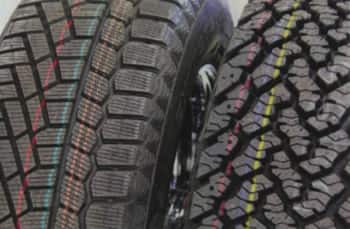 |
Right: We fired the engine a few hours before we hit the road using a Holley mechanical fuel pump and a MSD Ready-to-Run distributor that requires no external ignition box. We opted for an Odyssey 1500DT AGM battery to ensure our off-road lights, fog lights, cell phone charges, battery heater, engine block heater, oil pan heater, and every other accessory on the car had adequate power. And we tested the 135-minute reserve capacity when we coasted more than 30 miles down a mountain with the lights on and without a spinning alternator. This is one hell of a battery. We went with Continental ExtremeWinterContact rubber for the icy conditions we anticipated. The tread blocks are staggered farther apart than a regular al-season tire to help clear snow and ice from in between the lugs, the rubber if softer, and each block has multiple sipes for added grip. The tires on the right are 27×7.50-14 General Grabber AT2 all-terrains, which are designed for snow studs. Those are mounted on a used set of 14-inch slotted mags. We spent 58 bucks to have all four tires studded at a neighborhood tire shop in Utah. |
| How well does the are work? Well, the gears and cam are wrong. It cruises at 80 mph effortlessly at about 3,000 rpm but is pretty weak in the acceleration department because the engine really doesn’t start making steam until 3,500 rpm. Aside from that, it rides great, motors through snow like it was born to, and, amazingly, the tires are super-grippy in the dirt. Ignoring the teething problems from a rush-job installation, the RAUNCHero is well suited to long trips, off-road excursions, sliding around fire roads, and the occasional snowstorm. We have delusions of entering a few rally-cross events if time permits. We’ll see. HRM | 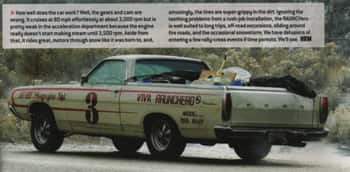 |
Ready to experience top-notch transmission solutions and expert support?

